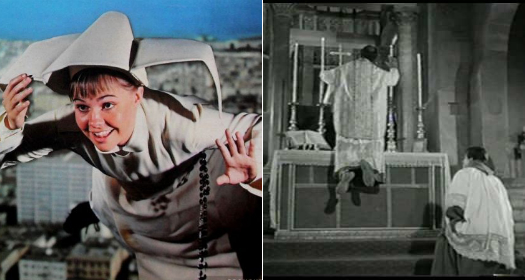Taking themselves lightly: “The Flying Nun” and The Reluctant Saint
“Angels can fly because they take themselves lightly,” Chesterton famously remarked. The title character in “The Flying Nun” has a more mundane explanation for her unusual ability: “When lift plus thrust is greater than load plus drag … well, anything can fly.” In her case, though, Chesterton’s explanation is possibly more convincing. (Seasons 1 and 2 of the series, which ran from 1967 to 1970, were recently released on DVD from Mill Creek Entertainment.)

Starring a young Sally Field (rebounding from the failure of “Gidget”), “The Flying Nun” followed closely on the heels of The Sound of Music and The Singing Nun, with the likes of “Bewitched” and “I Dream of Jeannie” going strong on the small screen.
Even so, debuting in the year of the Summer of Love, amid cultural milestones like The Graduate, The Outsiders and Sgt. Pepper, “The Flying Nun” was almost an instant anachronism. Still, “distance lends enchantment,” as an opening voiceover notes in one episode, and that might be true of this series, which found new popularity in syndication in the 1980s.
“The Flying Nun” offers the same sort of reassuring, cheery vision of Catholicism pioneered in the 1940s by Bing Crosby’s Father O’Malley in Going My Way and The Bells of St. Mary’s. In particular, there’s a similar contrast between a with-it young celibate and a traditional-minded foil, in this case Reverend Mother Placido (Madeleine Sherwood).
Despite her habit (including the large, starched cornette that, together with her slight frame and the windy climate of the Puerto Rico setting, is credited with her unusual ability), Sister Bertrille is a regular girl. Her fellow nuns first spot her playing cards — a habit she says she picked up recently in prison after being arrested during a free-speech rally. We later learn that in high school she was voted “Miss Far-out of 1965,” and she must be reminded that she is “a novice, not a teenybopper.”
Yet the conflict between the novice and the mother superior generally proves superficial. “We young sisters may approach things differently,” Sister Bertrille says, “but our aims are still the same.” In a sort of double subversion, “The Flying Nun” complicates the narrative of the young progressive gently leading the conservative into the future by portraying give and take in Sister Bertrille’s relationship with Mother Placido, each learning from the other.
Social issues are lightly touched on; the nuns run an orphanage and a hospital for the elderly, and many episodes revolve around Sister Bertrille’s efforts to raise money for the convent’s good works. In the end, though, “The Flying Nun” was a victim of its limited gimmick: There are only so many problems that can be solved (or caused) by a nun’s ability to fly.
If “The Flying Nun” is a bit too, well, flighty for some tastes, consider another 1960s production about a consecrated religious — a real-life one in this case, and a canonized saint — given to slipping the surly bonds of earth. The Reluctant Saint (1962) stars Maximilian Schell (fresh from his Oscar win for Judgment at Nuremberg) as Saint Joseph of Cupertino, a 17th-century Franciscan friar whose proneness to miraculous levitations is honored in his patronage of air travel. (Famously slow-witted, he is also patron of mental handicaps.)
Directed by Edward Dmytryk (The Caine Mutiny), the film is a gently humorous celebration of Franciscan simplicity, poverty of spirit and love of nature and animals. Though reverent and grave, it is lighter and earthier than other pious Golden Age fare, able to laugh both at its protagonist and even more at his formidable mother, the terror of every man who knows her.
Ricardo Montalban plays the antagonist, a learned but proud Franciscan offended by the divine favor bestowed on this holy fool, even ascribing his miracles to diabolical influence. The film includes perhaps the first extensive Hollywood depiction of an exorcism ritual — an exorcism that fails, of course, since Joseph isn’t possessed!
A humorously uplifting final coda, inexplicably edited from some home-video editions, has been restored in the DVD edition from Ignatius Press. (The DVD comes with a companion booklet for which I wrote the main essay.)
Related

The Reluctant Saint: Joseph of Cupertino (1962)
Like its protagonist, Saint Joseph Desa of Cupertino, throughout much of his lifetime and most of the film, Edward Dmytryk’s 1962 film The Reluctant Saint is a modest affair that has attracted little attention, but has more to offer than meets the eye.
Recent
- Crisis of meaning, part 3: What lies beyond the Spider-Verse?
- Crisis of meaning, part 2: The lie at the end of the MCU multiverse
- Crisis of Meaning on Infinite Earths, part 1: The multiverse and superhero movies
- Two things I wish George Miller had done differently in Furiosa: A Mad Max Saga
- Furiosa tells the story of a world (almost) without hope
Home Video
Copyright © 2000– Steven D. Greydanus. All rights reserved.